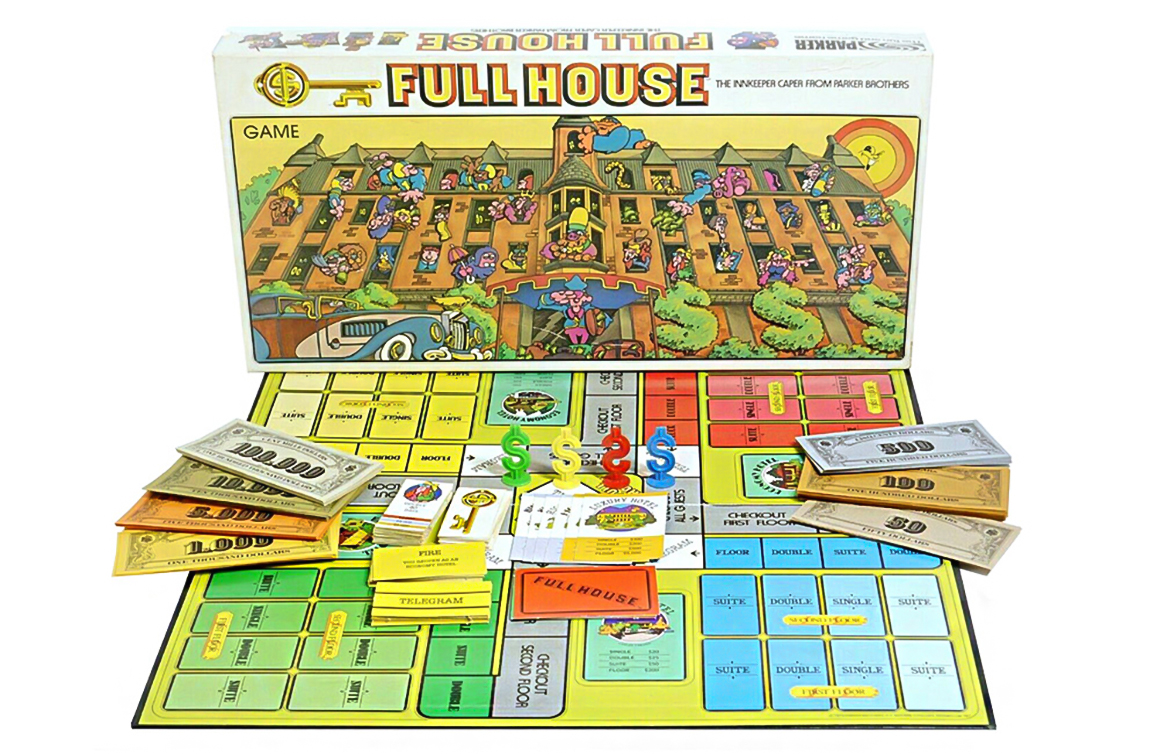Released in 1979 by Parker Brothers, the Full House board game saw players take the role of innkeeper and advance the status of their property and guests to become the wealthiest hotelier in the game.
GAMEPLAY
Players started the game at the economy property level with $7,500 in paper bills.
Telegram cards were shuffled and placed facedown at the centre of the board. Guest cards were shuffled and placed inside the people-popper, a plastic device used to slide out the cards.
The highest role started the game. Players began their turns by taking three guest cards from the people-popper and placing eligible guests in their eight-room hotel. Guest cards were whimsically illustrated as individuals, duos, groups, and animals.
Each player’s property included four suites — two singles and two doubles. Each guest card indicated a room size (a few prized guests reserved an entire floor), an eligible property level, and payment rates. Players could only accept guests eligible for their property level and only if the specific room option was vacant. Ineligible guests were optioned to opponents. Guests that could not be accommodated by any player were placed in a discard pile. Guests paid a variety of rates for their accommodations and players hoped to fill their hotels with the highest-paying guests.
After placing the guests in their hotel, a player rolled the dice, moved their pawn, and took the action indicated on the board. If a player landed on an opponent’s property, they paid a fee to that hotel owner. Players landing on a Telegram space would draw a Telegram card and take the directed action. Telegrams offered perks, such as tax refunds (an influx of money) and vetos (the ability to block a future unwelcome event). Telegrams also issued penalties, such as back taxes (financial payment to the bank), fires (downgraded property to economy level), and robberies (players had to part with a portion of their cash).
Stops along the board also allowed players to check out guests and receive payment for the transactions. Players wanted to move guests in and out of their property as quickly as possible to build their cash supply. As players accumulated money, they could pay to upgrade their properties. The race to upgrade was a vital element of the game, as the more prestigious the property, the more money guests paid and the more money an opponent would have to pay when landing on the property.
The first player to achieve luxury property status and save $500,000 won the game.
IN THE BOX
A complete game included a game board, four player pawns (red, yellow, blue, green), four sets of hotel rate cards (in colours corresponding to the player pawns), 48 guest cards, 30 telegram cards, paper money ($50, $100, $500, $1,000, $5,000, $10,000, and $100,000 denominations), one people-popper device, and one dice. An instruction booklet was also included.
COLLECTOR CONSIDERATIONS
Full House is considered rare these days. Copies can be found through online marketplaces more readily than in person. A note of caution: the plastic people-popper device used to distribute guests was hard on the corners of the cardboard cards. Collectors looking for a mint game may have to compile a game from multiple editions or patiently wait for an elusive unopened game.
Note: If you buy something using the eBay link in this story, we may earn a small commission. Thank you for supporting independent toy journalism!

